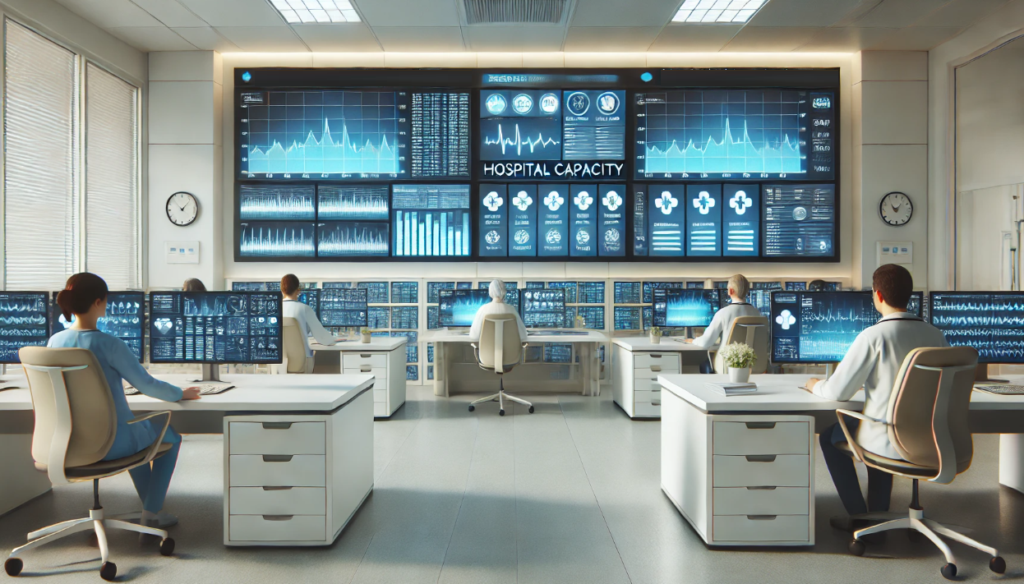The Growing Need for Hospital Command Centers
When you think of a command center, you might imagine a high-tech, dimly lit room filled with wall-sized monitors, a team of experts analyzing real-time data, and a leader making critical, split-second decisions. While this may sound like something out of a sci-fi movie, the reality of hospital command centers is just as impactful—though with fewer cinematic dramatics.
In recent years, hospitals and health systems have increasingly adopted hospital command centers to streamline operations, enhance patient flow, and optimize resource utilization. These centralized hubs leverage real-time data analytics to improve hospital efficiency and address common capacity challenges.
What Is a Hospital Command Center?
A hospital command center is a centralized unit that integrates multiple operational functions, such as patient transfers, bed management, staffing, and discharge coordination. These centers can be physical locations, virtual hubs, or hybrid models, depending on the hospital’s needs. Their primary goal is to improve patient throughput, reduce bottlenecks, and ensure optimal care delivery across single hospitals or entire health systems.
A 2022 national survey found that over 80% of responding health systems had implemented or were planning to launch a hospital command center, signaling the growing recognition of their value.
Key Reasons Hospitals Are Investing in Command Centers
Hospitals are turning to hospital command centers to solve persistent capacity and operational challenges. Here’s how they make a difference:
1. Reducing Emergency Department (ED) Boarding
Long ED boarding times—where patients wait for inpatient beds—can cause overcrowding, increase safety risks, and lead to longer hospital stays. The Joint Commission recommends hospitals aim for boarding times of four hours or less.
A hospital command center actively monitors ED capacity in real time, enabling hospitals to:
- Track the number of patients waiting for inpatient beds
- Identify departments with the highest demand for admissions
- Implement high-occupancy protocols such as ambulance diversion or early discharge requests
By managing these processes centrally, hospitals can minimize wait times and improve patient outcomes.
2. Optimizing Length of Stay (LOS)
Patients who remain hospitalized beyond their medically necessary stay occupy valuable beds, increasing costs and straining hospital resources. A hospital command center helps reduce LOS by:
- Coordinating patient flow from admission to discharge
- Identifying and eliminating discharge barriers, such as delays in medication, equipment, or testing
- Improving bed placement efficiency by aligning environmental services and bed management teams
With a system-wide view of patient status, hospital command centers can make data-driven decisions that enhance efficiency and reduce unnecessary hospital stays.
3. Improving Bed Utilization Across Hospitals
Health systems with multiple hospitals often struggle with imbalanced capacity—some facilities may be overcrowded while others have available beds. A hospital command center provides a global view of system-wide capacity, helping administrators:
- Redirect patients to appropriate facilities with open beds
- Reduce the number of patients occupying “wrong beds” (e.g., patients waiting for transfer to a lower level of care)
- Balance ICU and specialty unit capacity across multiple locations
By strategically managing bed utilization, hospital command centers help optimize care delivery while reducing bottlenecks at high-demand hospitals.
4. Managing Patient Transfers Efficiently
Hospitals often decline transfer requests due to a lack of available beds. This not only disrupts continuity of care but also impacts revenue. Hospital command centers enhance the transfer acceptance process by:
- Balancing internal hospital capacity with external demand
- Prioritizing transfers that align with the hospital’s specialized services
- Streamlining workflows to reduce transfer delays
With better coordination, hospitals can increase patient transfers, improve care access, and reduce revenue loss from declined cases.
5. Addressing Operating Room (OR) and Post-Anesthesia Care Unit (PACU) Boarding
PACU boarding happens when post-surgical patients remain in recovery waiting for an inpatient bed, causing delays in the operating room schedule. Similarly, OR holds occur when surgeries are postponed due to a lack of available recovery beds.
A hospital command center proactively manages surgical capacity by:
- Monitoring real-time bed availability for post-op patients
- Adjusting block scheduling to reduce variability in surgical volume
- Optimizing ICU admissions and step-down transfers to free up space
By improving surgical flow, hospital command centers help hospitals avoid costly OR delays and enhance overall efficiency.
6. Deploying Staff More Effectively
Healthcare staffing shortages have been a long-standing issue, worsened by the COVID-19 pandemic. While a hospital command center can’t increase staffing levels, it can maximize workforce efficiency by:
- Monitoring staffing-to-bed ratios in real time
- Deploying nursing float pools where they’re needed most
- Aligning housekeeping and transport staff with discharge timing to accelerate bed turnover
With better staffing coordination, hospital command centers ensure that the right personnel are in place to meet patient demand.
7. Expanding Centralized Patient Monitoring
Many hospitals are using hospital command centers to provide centralized patient monitoring services, such as:
- Tele-sitter programs for fall prevention
- Virtual ICUs for remote critical care support
- AI-driven sepsis detection and early intervention
These services enhance patient safety, improve response times, and reduce costs, particularly for smaller hospitals that may lack dedicated monitoring resources.
How Hospitals Can Build an Effective Command Center
The design and function of a hospital command center vary based on the institution’s size, goals, and operational challenges. However, successful command centers share key characteristics:
- Real-time analytics for patient flow, capacity, and staffing
- Cross-departmental collaboration to break down silos
- Leadership buy-in to drive system-wide adoption
- Scalability to expand services as hospital needs evolve
If your hospital is considering developing or expanding a hospital command center, working with capacity management experts can help ensure success. From strategic planning to implementation, hospitals can leverage best practices to build a high-performing command center that improves efficiency and patient outcomes.
James Henderson
CEO, mindzie






